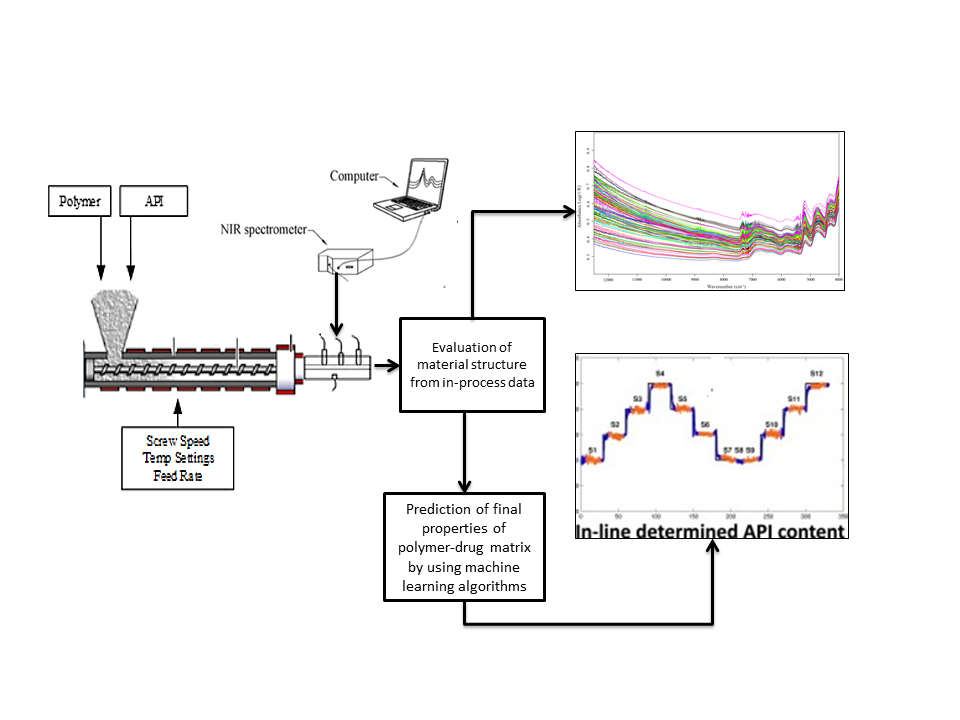Nimra Munir
Current PhD Student
In-line monitoring of Hot Melt Extrusion (HME) process to predict the final properties of polymer-drug marix
HME process will be used to incorporate drug into polymer, In the HME process for pharmaceuticals products, active pharmaceutical ingredients (API) are blended with the polymer carrier matrix with the help of the shear stresses applied by the extruder at a specific temperature. Applied shear stresses produce frictional energy that softens the polymer to embed the API in the polymer carrier matrix. Incorporation of drug into the polymer can be achieved in many different ways but HME has several advantages over other methods such as 1): HME combines many batch unit operations including mixing, melting, cooling, and other downstream operations in one process 2): HME is a solvent free process, so unlike other pharmaceutical process such as solvent extraction, spray drying etc., no additional step for the removal/drying of solvent is required, and HME is an environmental friendly process as well 3): Continuous process. In this project effect of varying processing conditions on the final properties of the polymer drug matrix will be analysed in detail. As processing conditions affect the degradation of the polymer-drug matrix, polymer-drug interactions, dispersion of the API, the crystallinity of the drug and other factors critical to mechanical properties, degradation rate and drug release behaviour. The effects of process conditions on these factors are complex and specific to the materials. That is why Identification of suitable process conditions is extremely important for a successful HME of polymer-drug matrix. One of the main issues faced by current pharmaceutical industry is the use of off-line lab-based method for product quality testing, off-line lab-based methods are time consuming and expensive; resulting in slow feedback to process optimisation. The time and cost of process development can inhibit the commercialisation of novel products despite of their clinical potential. To address this issue Near infra-Red (NIR) and UV-Vis spectroscopy will be implemented in-line to monitor the changes polymer-drug matrix will go through in real-time. Interpretation of spectra is challenging as spectra contain broad, overlapping overtones and combination bands. However, by using appropriate machine learning algorithm/s relevant information can be fetched from NIR and UV-Vis spectra. Thus, in this project, In-line collected NIR and UV-Vis data will be analysed by using appropriate machine learning algorithm/s.
The main aim of this project is to enhance the process control of HME of polymer-with drug to reduce the development time and cost, following are the objectives of this project;
1): Use of in-line NIR and UV-Vis spectrometer.
2): Effect of varying process conditions on the final properties of polymer-drug matrix
3): Development of soft sensor using in-line data captured by NIR, UV-Vis, pressure, and temperature sensors, to predict the final properties of polymer-drug matrix including drug release profile, degradation of drug/polymer, mechanical properties etc.
4): More than one polymer and drug system will be analysed.

Bio: My BS degree in chemical engineering is from University of Enginnering and Technology Lahore, Pakistan. My final year project tiltle was “production of bio-ethanol from pre-treated wheat straw using simultanous sccarification and fermintation process”. After BS I worked for Forward sports (official manufacturer of Adidias) as a research engineer for 2.5 years. My research was on developing eco-friendly materials, inks and paints for manufactring and printing on footballs and bags. For my masters I was awarded full scholarship from University of Bradford, UK. I completed my masters degree in chemical and petroleum engineering in jan-2019. My masters dissertation titile was “ Effect of Graphene Nano-Plateltes (GNP) on the mechanical, rheological and thermal properties of polypropylene”.
Presentations
CUA-2019 conference
Chemistry le cheile conference-2020
Collaborations
Athlone institute of technology – applied polymer technologies (APT)
University of Limerick- bernal institute
